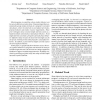Free Online Productivity Tools
i2Speak
i2Symbol
i2OCR
iTex2Img
iWeb2Print
iWeb2Shot
i2Type
iPdf2Split
iPdf2Merge
i2Bopomofo
i2Arabic
i2Style
i2Image
i2PDF
iLatex2Rtf
Sci2ools
ISPASS
2005
IEEE
2005
IEEE
Motivation for Variable Length Intervals and Hierarchical Phase Behavior
Most programs are repetitive, where similar behavior can be seen at different execution times. Proposed algorithms automatically group similar portions of a program’s execution into phases, where the intervals in each phase have homogeneous behavior and similar resource requirements. These prior techniques focus on fixed length intervals (such as a hundred million instructions) to find phase behavior. Fixed length intervals can make a program’s periodic phase behavior difficult to find, because the fixed interval length can be out of sync with the period of the program’s actual phase behavior. In addition, a fixed interval length can only express one level of phase behavior. In this paper, we graphically show that there exists a hierarchy of phase behavior in programs and motivate the need for variable length intervals. We describe the changes applied to SimPoint to support variable length intervals. We finally conclude by providing an initial study into using variable le...
ISPASS 2005 | Length Intervals | Phase Behavior | Software Engineering | Variable Length Intervals |
| Added | 25 Jun 2010 |
| Updated | 25 Jun 2010 |
| Type | Conference |
| Year | 2005 |
| Where | ISPASS |
| Authors | Jeremy Lau, Erez Perelman, Greg Hamerly, Timothy Sherwood, Brad Calder |
Comments (0)

